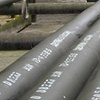

Hunan Standard Steel as a member of Husteel Industry Group, is a professional manufacturer of mild steel pipes and pipe fittings, which has a complete system of production... More
Factory GroupTechnical requirements of pipeline
Date:2018-01-03
Views:2598
Pipeline is used to transport oil, natural gas and other large-diameter welded steel pipe with hot-rolled coil or heavy plate. Pipeline steel in use, in addition to the requirements of higher compressive strength, but also requires a high temperature toughness and excellent welding performance. Compared with the X70 pipeline used in the West-East Gas Pipeline Project, the yield strength of K60 pipeline steel is comparable with that of X70 pipeline steel, but its tensile strength is higher than that of X70 pipeline steel.
1. Pipeline steel
Plate and coil for the manufacture of oil, natural gas, long-distance pipelines or coal, building material slurry pipes, etc. are called steelforpipelines. Generally used in thick-walled thick-walled longitudinal welded pipe, and the coil for the production of straight seam resistance welded pipe or submerged spiral welded pipe. Domestic production capacity of 700,000 t / a spiral welded pipe with a diameter of less than 1800mm has been established in China. In recent years, a production line of straight seam thick-walled welded pipes with a caliber of less than 1600mm has been established. The domestic production of pipeline steel that meets the design requirements of the pipeline project of API 5L standard is only 10 years old, with Baosteel being the most important, as well as Ansteel, WISCO, Panzhihua Iron and Steel, Jiuquan Iron and Steel, Wugang, and other stable production of X60 ~ X70 grade pipeline steel in the international market occupies a certain position, has put into production X80 grade pipeline quality has reached the international advanced level, X100 grade pipeline steel has been developed, not yet put into mass production.
2. Technical requirements of pipeline
Modern pipelines are low-carbon or ultra-low carbon microalloyed steel, high-tech content and high value-added products, the production of pipelines almost all application of the metallurgical field nearly 20 years of all new achievements in process technology. The current pipeline project development trends are large diameter, high pressure gas transportation, cold and corrosion of the service environment, the thick-walled subsea pipeline. Therefore, modern pipeline steel should have high strength, high toughness and resistance to brittle fracture, low welding carbon content and good weldability, as well as anti-HIC and anti-H2S corrosion. Optimized production strategy is to improve the cleanliness and uniformity of steel, C≤0.09%, S≤0.005%, P≤0.01%, O≤0.002%, and take the micro-alloying, vacuum Degassing + CaSi, soft reduction in continuous casting, multi-stage thermo-mechanical rolling, and multi-functional intermittent accelerated cooling. At present, there is no toughness index for pipeline steel in pipeline specification at home and abroad, there are only specific requirements for the pipe material:
(1) Minimum service temperature (-5 ℃) DWTT ≥ 85% SA;
(2) Charpy impact absorption power ≥145J at minimum operating temperature (-5 ℃).
At present, the technical conditions of pipeline steel are generally American Petroleum Institute standards API Spec 5L, but the technical conditions of ordering specific domestic or specific users are often much more strict than API standards.
1. Pipeline steel
Plate and coil for the manufacture of oil, natural gas, long-distance pipelines or coal, building material slurry pipes, etc. are called steelforpipelines. Generally used in thick-walled thick-walled longitudinal welded pipe, and the coil for the production of straight seam resistance welded pipe or submerged spiral welded pipe. Domestic production capacity of 700,000 t / a spiral welded pipe with a diameter of less than 1800mm has been established in China. In recent years, a production line of straight seam thick-walled welded pipes with a caliber of less than 1600mm has been established. The domestic production of pipeline steel that meets the design requirements of the pipeline project of API 5L standard is only 10 years old, with Baosteel being the most important, as well as Ansteel, WISCO, Panzhihua Iron and Steel, Jiuquan Iron and Steel, Wugang, and other stable production of X60 ~ X70 grade pipeline steel in the international market occupies a certain position, has put into production X80 grade pipeline quality has reached the international advanced level, X100 grade pipeline steel has been developed, not yet put into mass production.
2. Technical requirements of pipeline
Modern pipelines are low-carbon or ultra-low carbon microalloyed steel, high-tech content and high value-added products, the production of pipelines almost all application of the metallurgical field nearly 20 years of all new achievements in process technology. The current pipeline project development trends are large diameter, high pressure gas transportation, cold and corrosion of the service environment, the thick-walled subsea pipeline. Therefore, modern pipeline steel should have high strength, high toughness and resistance to brittle fracture, low welding carbon content and good weldability, as well as anti-HIC and anti-H2S corrosion. Optimized production strategy is to improve the cleanliness and uniformity of steel, C≤0.09%, S≤0.005%, P≤0.01%, O≤0.002%, and take the micro-alloying, vacuum Degassing + CaSi, soft reduction in continuous casting, multi-stage thermo-mechanical rolling, and multi-functional intermittent accelerated cooling. At present, there is no toughness index for pipeline steel in pipeline specification at home and abroad, there are only specific requirements for the pipe material:
(1) Minimum service temperature (-5 ℃) DWTT ≥ 85% SA;
(2) Charpy impact absorption power ≥145J at minimum operating temperature (-5 ℃).
At present, the technical conditions of pipeline steel are generally American Petroleum Institute standards API Spec 5L, but the technical conditions of ordering specific domestic or specific users are often much more strict than API standards.





















